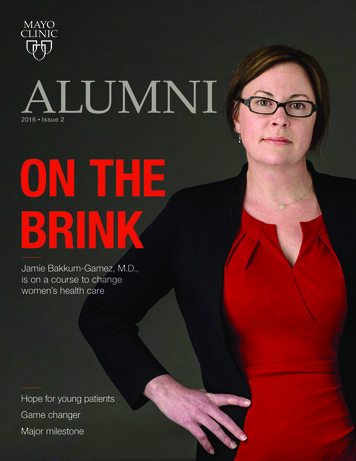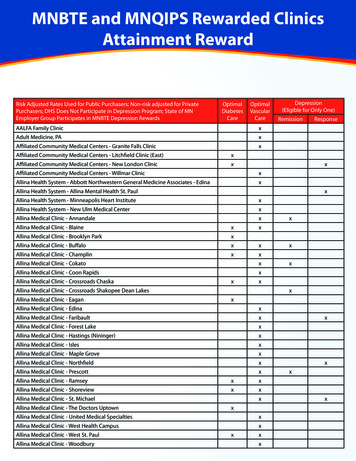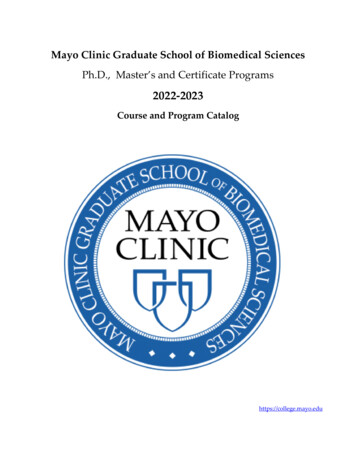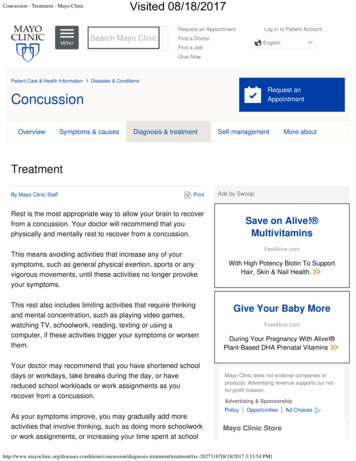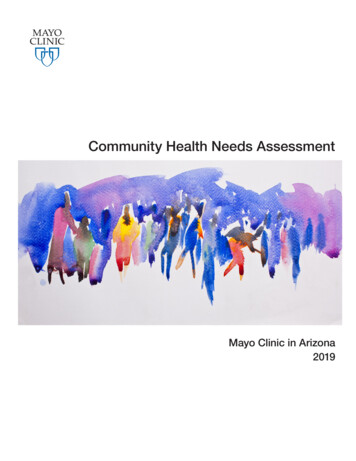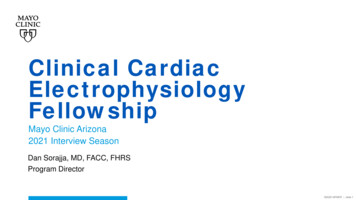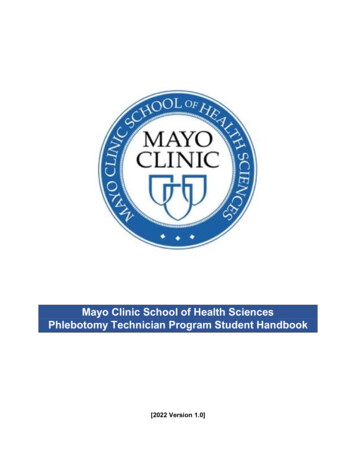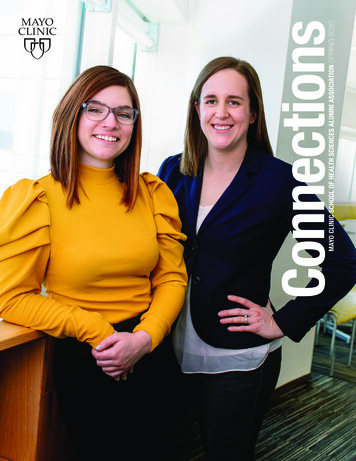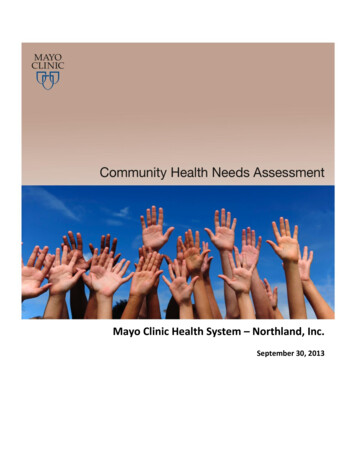
Transcription
Mayo Clinic Health System – Northland, Inc.September 30, 2013
Table of ContentsExecutive Summary . 3Our Community . 6Assessing the Needs of the Community . 9Addressing the Needs of the Community . 13Appendix A: Additional Demographics . 17Appendix B: Individuals Involved in CHNA . 18Appendix C: County Health Rankings . 21Appendix D: Data Sources . 22Appendix E: Prioritization Matrix . 24Page 2 of 24
Executive SummaryEnterprise Overview:Mayo Clinic is a not-for-profit, worldwide leader in patient care, research and education. Each yearMayo Clinic serves more than one million patients from communities throughout the world, offering afull spectrum of care from health information, preventive and primary care to the most complexmedical care possible. Mayo Clinic provides these services through many campuses and facilities,including 23 hospitals located in communities throughout the United States, including Arizona, Florida,Georgia, Minnesota, Wisconsin and Iowa.A significant benefit that Mayo Clinic provides to all communities, local to global, is through itseducation and research endeavors. Mayo Clinic reinvests its net operating income funds to advancebreakthroughs in treatments and cures for all types of human disease, and bring this new knowledgeto patient care quickly. Through its expertise and mission in integrated, multidisciplinary medicine andacademic activities, Mayo Clinic is uniquely positioned to advance medicine and bring discovery topractice more efficiently and effectively.In addition, through its Centers for the Science of Health Care Delivery and Population HealthManagement, Mayo Clinic explores and advances affordable, effective health care models to improvequality, efficiency and accessibility in health care delivery to people everywhere.Entity Overview:Mayo Clinic Health System – Northland in Barron is a 25-bed critical access hospital located in Barron,Wis. Since 1959, the hospital has been dedicated to promoting health and meeting the health careneeds of our patients.Mayo Clinic Health System – Northland in Barron is one of 17 hospitals within Mayo Clinic HealthSystem. This location is part of the Northwest Wisconsin region of Mayo Clinic Health System, whichalso includes hospitals in Eau Claire, Bloomer, Menomonie and Osseo. It supports the communitythrough inpatient and outpatient services and had 911 admissions in 2012. The hospital has 445employees.Mayo Clinic Health System is a family of clinics, hospitals and health care facilities serving more than 70communities in Iowa, Georgia, Wisconsin and Minnesota. It includes more than 900 providers andserves more than half a million patients each year. As part of Mayo Clinic, a leading caregiver withnearly 150 years of patient care, research and medical education expertise, the organization provides afull spectrum of health care options to local neighborhoods, ranging from primary to highly specializedcare. Mayo Clinic Health System is recognized as one of the most successful regional health caresystems in the United States.Page 3 of 24
Through the power of collaboration Mayo Clinic Health System provides patients with access tocutting-edge research, technology and resources that comes from Mayo Clinic. Our communities havethe peace of mind that their neighbors are working together around the clock on their behalf.Mayo Clinic Health System was developed to bring a new kind of health care to local neighborhoods.By putting together integrated teams of local doctors and medical experts, we've opened the door toinformation sharing in a way that allows us to keep our family, friends and neighbors healthier thanever before.Mayo’s greatest strength is translating idealism into action. It's what our staff does every day for ourpatients. It’s how we transform hope into healing. We call this power "the Mayo Effect."Mayo Clinic Health System was created to fulfill Mayo’s commitment to bring quality health care tolocal communities. As part of this commitment, Mayo Clinic Health System has a long tradition ofsupporting community health and wellness. In 2012 Mayo Clinic Health System – Northland in Barronprovided nearly 3.4 million in community benefit through uncompensated care. Northland alsoprovided 13,372 through philanthropic donations to support such programs as Meals on Wheels, freebike helmets for children, bloodmobile, first aid kits for youth sports teams, medical coverage at youthsporting events and county economic development. In 2012, approximately 10,020 residents werereached through community support and health and wellness activities.Mayo Clinic Health System – Northland in Barron provided a wide range of wellness and preventionprograms for the community, including free blood pressure and free glucose screenings. In 2012, theorganization offered a free stop-smoking class, several career exploration presentations, free diabeteseducation sessions and wellness information at several area health fairs.Several community collaboration activities took place in 2012, including free physician consultation forFamily Planning Services of Barron County, county emergency preparedness, social worker supportservices, free school supplies to area schools and sponsorship of hand- washing stations at outdoorfairs and festivals. In addition, approximately 120 hours of staff time was allotted to assist PublicHealth to assess the needs and develop a plan to improve the health of Barron County residents(Community Health Improvement Plan.)The Mayo Clinic Health System community health needs assessment process will advance andstrengthen our commitment to community health and wellness activities by providing focus on highpriority needs and bringing additional needs to light.Summary of Community Health Needs Assessment:The Mayo Clinic Health System – Northland in Barron community assessment process was led by aregional Community Health Needs Assessment Committee (CHNAC). That committee followed asystematic approach to evaluate the health needs of our communities and determine their healthpriorities.Page 4 of 24
The primary input into the assessment and prioritization process was the “Thrive Barron County:Growing Together in Health” report. In 2012, this community-wide assessment was completed.” Asteering committee, consisting of public health and all hospitals and clinics in the county, metthroughout 2012 to plan the assessment. A paper/electronic survey was completed by 1,113community members. In September 2012, more than 100 community members attended an all–daycommunity health assessment workshop to assess and analyze health data specific to Barron County.The Wisconsin Department of Health Services’ most recent health agenda, Healthiest Wisconsin 2020,as well as County Health Rankings completed by the Centers for Disease Control also were taken intoconsideration.After completing an extensive analysis of the Barron County Thrive report, Healthiest Wisconsin 2020and other quantitative and qualitative data, the top community health needs identified as Mayo ClinicHealth System – Northland in Barron’s priorities are:1. Chronic disease prevention and management2. Physical activity3. Adequate, Appropriate and Safe Food and NutritionPage 5 of 24
Our CommunityGeographic Area:Mayo Clinic Health System – Northland in Barron is located in Barron County in northwesternWisconsin. Barron has a population of 3,423, while Barron County has 45,870 residents. Barron Countyis considered 100 percent rural. Mayo Clinic Health System – Northland in Barron’s primary servicearea is Barron County. This report is based on the needs of the residents of Barron County. Residents ofthe county accounted for 84 percent of the hospital inpatient discharges in 2012.Demographics:The population in the Northland region is young with 22 percent of the population under 18 and 30percent between the ages of 18 and 44. Currently, only 18 percent is over 65. However, the 65 agegroup is growing at a rapid pace and currently is the second-largest population segment. Thepopulation is made up primarily of high school graduates and individuals who have obtained somecollege education. This education level is reflected in the population income distribution, with themajority of the population making under 50,000 per year (61 percent.)The largest ethnic populations are Hispanic/Latino at 1.9 percent and Black/African American at 1.2percent for the 2010 census.Additional demographic detail can be found in Appendix A.There are two additional hospitals in Barron County: Lakeview Medical Center in Rice Lake andCumberland Health Care in Cumberland. There are two hospitals in neighboring Eau Claire County thatprovide secondary and tertiary level care (Mayo Clinic Health System in Eau Claire and Sacred HeartHospital.) Mayo Clinic Health System in Eau Claire also provides Level II trauma care. As a member ofMayo Clinic Health System, Northland has seamless access to the care offered in Eau Claire, as well asPage 6 of 24
the world-renowned Mayo Clinic in Rochester, Minn. In addition, the residents of Barron County haveaccess to the following:Mental health clinics Barron County Community Support Program, Rice Lake Callier Clinic, Rice Lake Marshfield Clinic, Rice Lake Mayo Clinic Health System, Northland in Rice Lake Omne Clinic, Barron Several independent counselors (click on mental health clinics link above for complete list)Dental clinics Joan Decker, DDS, Barron Cameron Dental Kevin Master, DDS, Cameron Midwest Dental, Chetek Cumberland Family Dental Dr. Hallgren, Cumberland Patrick Liedl, Turtle Lake Lakeview Dental Clinic, Rice Lake Haack Orthodental Clinic, Rice Lake Arrowhead Family Dental, Rice Lake Rice Lake Dental Center Several independent dentists in Rice LakeNursing homes Mayo Clinic Health System-Northland in Barron Barron Care and Rehab Knapp Haven Nursing Home, Chetek Cumberland Memorial Hospital ECU Dallas Care and Rehab Pioneer Nursing Home, Prairie Farm Heritage Manor, Rice Lake Rice Lake Convalescent CenterAssisted-living facilities Mayo Clinic Health System–Northland in Barron Brentwood Senior Communities, Rice Lake Pelican Place, Chetek Thomas Landing, Rice Lake Monroe Manor, Barron New Beginnings of Barron County, Rice LakePage 7 of 24
Northwood Gables, Rice LakeOur House Assisted Care, Rice LakeOur House Memory Care, Rice LakeAurora Residential Alternatives, ComstockCare Partners Assisted Living, Rice LakeChetek Rivers EdgeChrismark Home, Rice LakeCountry Terrace of Wisconsin, Rice LakeHansen’s Group Home, BarronHunter Home Services, BarronIntegricare, CameronMagna house of Barron County, Rice LakeDrug treatment facilities ABR Counseling, Rice Lake Arbor Place, Rice Lake Barron County Health & Human Services, BarronPage 8 of 24
Assessing the Needs of the CommunityOverview:Mayo Clinic Health System – Northland in Barron identified and prioritized community health needsthrough a comprehensive process that included input from a cross section of community andorganizational leadership as well as direct input from the community. The assessment was particularlyaimed at understanding the needs of the traditionally underserved in the community.The Mayo Clinic Health System regional Community Health Needs Assessment Committee (CHNAC) ledthe process of evaluating the health needs of our communities and determining our community healthpriorities. The committee was chaired by the regional chief executive officer and included leadershiprepresentation from the Northwest Wisconsin region of Mayo Clinic Health System which is comprisedof five hospitals located in Eau Claire, Barron, Bloomer, Menomonie and Osseo. Committee memberswere chosen for their expertise in directly providing services to meet the health needs of ourcommunities and for their involvement in existing community programs and services. The committeewas responsible for creating a thorough and organized needs assessment process as well as fordeveloping an effective plan to meet the identified needs.Process and Methods:The assessment process began with a thorough review of the Barron County Community Health NeedsAssessment (CHNA.) The purpose of the county report is to assess the needs in our community,identify community resources to address the most urgent needs and encourage action plans that solvecommunity problems.In January 2011, a group of health care leaders formed a steering committee to lead the CHNA forBarron County. Founding members of the steering committee include: Jolene Anderson, Marshfield ClinicDeb Dietrich, Mayo Clinic Health SystemKelli Engen, Barron County Public HealthLaura Johnson, Be Well Barron County CoalitionJenny Jorgenson, Mayo Clinic Health SystemLisa Laatsch, Lakeview Medical CenterBeverly Mahler, University of Eau Claire Student NurseHeidi Massey, Western Regional Office, Public HealthChar Mlejnek, Lakeview Medical CenterKaren Morris, Western Regional Office, Public HealthDanessa Sandmann, AmeriCorps, Lakeview Medical CenterLaura Sauve, Barron County Public HealthRita Sullivan, Mayo Clinic Health SystemPage 9 of 24
Sarah Turner, Safe and Stable Family CoalitionBobbi Wyss, Cumberland Health CareJoe Willger, Marshfield ClinicThe steering committee sought guidance on the process from the Wisconsin State Department ofHealth (Karen Morris and Heidi Massey.)The group researched best practices for conductingcommunity assessments by reviewing materials and talking to representatives from other counties thathad completed the task. A planning timeline and outline for the assessment was developed to keep theproject moving forward.Data for Barron County was compiled by the committee for the following three areas to use in theCHNA process: DemographicsCommunity perception surveyHealthy Wisconsin 2020 Health PrioritiesCommunity perception surveyThe county CHNA included a random household survey. The objective was to increase theunderstanding of the community’s health needs and its perception of the main challenges facing theresidents of Barron County. Surveys were distributed to libraries, hospitals, clinics, the free clinic, foodpantries and senior centers. A press release was sent to area newspapers announcing the initiative andasking for community participation. The survey process also was explained and promoted on themorning talk radio show on WJMC in Rice Lake.The survey was translated into both the Spanish and Somali languages (prevalent populations in BarronCounty) to ensure that the opinions of those populations were included. The committee received 13Somali surveys and 12 Spanish surveys.More than 1,100 surveys were completed both online and on paper. The results were tabulated andweighted. Based on the surveys returned, community members felt the health issues in Barron Countywere:1. Alcohol and drugs 23.0 percent2. Chronic disease 12.0 percent3. Nutrition 10.8 percent3. Physical activity 10.8 percent5. Tobacco 8.6 percent6. Mental health 7.4 percent7. Injury and violence 6.5 percent8. Oral health 4.6 percent9. Growth and development 4.2 percent10. Reproductive health 4.1 percentPage 10 of 24
11. Communicable disease 3.2 percent12. Environment 2.2 percentNo answer 0.4 percentThe steering committee used Healthiest Wisconsin 2020 as a foundation to conduct the datacollection. Healthiest Wisconsin 2020 encompasses two main focus areas: 1) cross cutting, whichincludes eliminating health disparities and socio-economic and educational determinants; and 2)health, which includes 12 focus areas: Alcohol and drug useChronic disease prevention and managementCommunicable diseasesEnvironmental and occupational healthHealthy growth and developmentInjury and violence preventionMental healthNutrition and healthy foodsOral healthPhysical activityReproductive and sexual healthTobacco use and exposureThe complete Healthiest Wisconsin 2020 plan can be found e committee hosted a Community Planning Day on September 12, 2012, inviting business leaders,health experts and the general community to select the top three health priorities for Barron County.Community experts on each of the 12 areas also were invited to ensure that along with communitymembers, people who have a working understanding of the issues were included in the process.Small group sessions on each priority area were charged with giving three reasons why that priorityshould be chosen as a Barron County health priority. These small groups then made their case to thelarge group. After the presentations were made, and community input from the March 2012 surveyswas considered, a vote was taken to determine the top three priorities, which were:1. Alcohol and drugs2. Mental health3. Chronic diseaseThe CHNAC also reviewed a wide range of secondary data sources including health, demographic andsocio-economic qualitative data. A full citation of data sources is included in Appendix B.Page 11 of 24
One of the main data sources was County Health Rankings provided by the Centers for Disease Control.Launched in 2010, the program aimed to produce county level health rankings for all 50 states. TheCounty Health Rankings identify the multiple factors that determine a county’s health status, includingenvironment, education and jobs, individual behaviors, access to services and health care quality.County Health Ranking Data for Barron County has been included as Appendix C.Prioritization processThe CHNAC used these data sources and the county CHNA to compile a thorough listing of communityhealth needs. Identified needs were evaluated using a matrix called the CHNA Process to Identify &Prioritize Needs. Each need was measured on a set of criteria, which then was given a ranking of high,medium or low for each criteria. The criteria used were: comparison to state and national goals,community impact, the organization’s ability to impact change, community readiness for change, gapsin community resources, and the voice of local customer. The prioritization matrix is included asAppendix D.Page 12 of 24
Addressing the Needs of the CommunityOverviewAfter completing an extensive analysis of the county CHNA, Healthiest Wisconsin 2020, County HealthRankings and other quantitative and qualitative data, the top community health needs identified asMayo Clinic Health System – Northland in Barron priorities are: Chronic disease prevention and managementPhysical activityAdequate, Appropriate and Safe Food and NutritionChronic disease prevention & managementAccording to Healthiest Wisconsin 2020, the goals of chronic disease prevention and management are“to prevent disease occurrence, delay the onset of disease and disability, lessen the severity of diseaseand improve the health-related quality and duration of the individual's life.”Four modifiable health risk behaviors— unhealthy diet, insufficient physical activity, tobacco use andsecondhand smoke exposure, and excessive alcohol use — are responsible for much of the illness,suffering and early death related to chronic diseases. Prevention is not always possible, so it isimportant that effective management of chronic disease be part of the health care system.Although chronic diseases usually become clinically apparent in adulthood, the exposures and riskfactors that precede disease onset occur at every stage of life. Childhood and adolescence are criticaltimes to deliver and reinforce health education messages.Data HighlightsChronic diseases, such as heart disease, stroke, cancer, diabetes, asthma and arthritis, are among themost common and costly of all health problems in the United States. Currently, seven of the 10 leadingcauses of death in Wisconsin and the U.S. are due to chronic diseases, accounting for approximatelytwo out of every three deaths annually. Cardiovascular disease is consistently the leading cause of mortality for Wisconsin residents,accounting for more than 16,000 deaths annually, or 35 percent of all deaths.Each year from 2002 through 2006, an annual average of 27,256 cancers were diagnosedamong Wisconsin residents. The average age-adjusted incidence rate for all cancers was 470.3per 100,000 Wisconsin residents.From 2004 to 2007, diabetes-related hospitalizations increased nearly 11 percent, from 85,113to 94,331. Diabetes prevalence among adults increased more than 27 percent, from 329,460 to419,870.In 2005, more than 5,500 Wisconsin residents were hospitalized for asthma and more than22,000 sought emergency room care for asthma.Page 13 of 24
More than 27 percent of Wisconsin adults aged 18 years and older (1.1 million) reported theyhad some form of arthritis during 2003–2007.Chronic diseases are several of the leading causes of death in Barron County, Wisconsin and thenation.Annually, on average 63 percent of deaths in Barron County are due to chronic disease.In 2009, 12.8 percent of hospitalizations in the county were chronic disease related, while only6.5 percent were injury-related.In Barron County, an estimated 9 percent of the population (over 4,100 residents) is living withdiabetes. However, only 6.6 percent of that number has been officially diagnosed with thedisease, and even fewer are successfully managing their blood sugars.Consistently, heart disease is the leading cause of death in Barron County, accounting for nearlya quarter of deaths annually.In 2009, an estimated 9.1 million was spent on coronary heart disease hospitalizations inBarron County, with nearly 5 million incurred by patients over 65.Additional information included in the Healthiest Wisconsin 2020 Health Focus Areas report can befound here: pdfPhysical activityLimited physical activity is closely linked to obesity (a major risk factor for cardiovascular disease,certain types of cancer, type 2 diabetes and other chronic diseases.) Obesity is defined by the Centersfor Disease Control and Prevention as “a body mass index (BMI) of 30 or greater. BMI is calculatedfrom a person's weight and height and provides a reasonable indicator of body fatness and weightcategories that may lead to health problems.” U.S. and Wisconsin rates of obesity have risen steadilyover the past 20 years, with a leveling off in recent years. The Behavioral Risk Factor SurveillanceSystem results for 2008 indicate that 26.7 percent of the U.S. population and 26.1 percent of theWisconsin population were obese.Data highlightsObesity, the second leading cause of death in the U.S., has increased significantly from 2000 to 2010.This increase has occurred nationally, as well as in Minnesota, Wisconsin and Barron County. Levels of physical activity trends in Wisconsin have shown a slight increase since 2001. Theproportion of residents meeting the minimum physical activity recommendations rose from 52percent (2001) to 55 percent (2007.) Nearly half the population of Wisconsin does not meet therecommendations for physical activity. Twenty-six percent of Wisconsin adults are obese and 64 percent are overweight or obese. Twenty-three percent of high school students are overweight or obese. According to Behavioral Risk Factor Surveillance System Survey data, 59 percent of adult womenand 77 percent of adult men in Barron County are overweight or obese. Approximately 27percent of adults in the county report their rate of physical activity as “inactive.” In one Barron County high school, 37 percent of students in grades 9 through 12 wereoverweight or obese, according to BMI data obtained from the Be Well Barron County program.Page 14 of 24
Additional information included in the Healthiest Wisconsin 2020 Health Focus Areas report can befound here: pdfAdequate, appropriate and safe food and nutritionAccording to Healthiest Wisconsin 2020, adequate, appropriate and safe food and nutrition means theregular and sufficient consumption of nutritious foods across the life span, including breastfeeding, tosupport normal growth and development of children and promote physical, emotional and social wellbeing for all people. Good nutritional practices also can reduce the risk for a number of chronicdiseases, which are major public health problems, including chronic conditions such as obesity, type 2diabetes, cancer, heart disease and stroke.Data highlightsObesity is one of the most critical health issues of our time. Overweight and obesity describe ranges ofweight for a certain height that are higher than that considered healthy. Obesity is a paramount healthconcern for Wisconsin and the nation because of its strong relationship to many negative healthconditions and outcomes, such as type 2 diabetes, cardiovascular disease, certain cancers, arthritis,asthma, depression and negative pregnancy and birth outcomes. Obese youth are also much morelikely to become obese adults, putting them at risk for having lifelong health consequences.Poverty in Wisconsin rose substantially during the 2000s. In 2009, 12.4 percent of the state’spopulation was living in poverty, increasing to 13.2 percent in 2010. Poverty puts households at a muchgreater risk of experiencing food insecurity and hunger. Households that are food insecure haveuncertain access to food.Data about the prevalence of obesity have been included under physical activity. Along with thosestatistics, about 14 percent of adults and 7 percent of high school students eat fruit at least twice perday and vegetables at least three times per day.Additional information included in the Healthiest Wisconsin 2020 Health Focus Areas report can befound here: pdfHealth needs not addressedThrough our assessment process, the CHNAC identified other community health needs that have notbeen addressed in this community health improvement plan. In prioritizing community health needs,the CHNAC took into consideration other community organizations addressing the need in question,the core competencies of Mayo Clinic Health System and our ability to impact change, as well as thereadiness of the community for interventions. Access to dental care: This is outside the expertise and resources available at the hospital.Alcohol and drug use/abuse: Other agencies in the county are addressing these issues, andthey are generally out of scope for Mayo Clinic Health System.Tobacco: We will continue to support the decrease in tobacco use through patient education.Page 15 of 24
Mental health: This is a core service of Mayo Clinic Health System, which we will continue toaddress to meet the needs of our patients. Lack of medical providers in the county wasidentified during the assessment, and in July 2013, a full- time psychiatrist was added to MayoClinic Health System – Northland in Rice Lake.Page 16 of 24
Appendix A: Additional DemographicsBarron CountyPopulation: 45,707Population in poverty: 11.4%*Unemployment rate: 8.4%**Uninsured ages 18-64: 8.5%Uninsured under 18: 0.9%Adults 25 years with high school education or less: 53.5%Page 17 of 24
Appendix B: Individuals Involved in CHNABarron County CHNA Steering Committee Jolene Anderson, Marshfield Clinic Deb Dietrich, Mayo Clinic Health System Kelli Engen, Barron County Public Health Laura Johnson, Be Well Barron County Coalition Jenny Jorgenson, Mayo Clinic Health System Lisa Laatsch, Lakeview Medical Center Beverly Mahler, University of Eau Claire Student Nurse Heidi Massey, Western Regional Office, Public Health Char Mlejnek, Lakeview Medical Center Karen Morris, Western Regional Office, Public Health Danessa Sandmann, AmeriCorps, Lakeview Medical Center Laura Sauve, Barron County Public Health Rita Sullivan, Mayo Clinic Health System Sarah Turner, Safe and Stable Family Coalition Bobbi Wyss, Cumberland Health Care Joe Willger, Marshfield ClinicPersons with special knowledge and expertise in public health Judy Demars, HHS Director Kelli Engen, RN Health Officer Laura Sauve, RN, Public Health Nurse Marla Pritz, WIC Nancy Drake, Wisconsin Women Well ProgramGovernment agencies with knowledge of relevant health needs of the community Health and Human Services UW Extension office Veteran's Affairs Aging and Disability office Birth to Three ProgramMedically underserved representatives Judy Demars, HHS Director Kelli Engen, RN Health officer Laura Sauve, RN Public Health nurse Marla Pritz, WIC Nancy Drake, Wisconsin Women Well Program Clare Janty, Rice Lake Free Clinic Charlene Oftadahl, Office on Aging, Marshfield Dental ClinicPage 18 of 24
Minority populations Workforce Development Barron County International Center, Nasra Xashi Health and Human Services Veteran's ServicesLow income representatives Judy Demars, HHS director Kelli Engen, RN Health officer Laura Sauve, RN Public Health nurse Marla Pritz, WIC Nancy Drake, Wisconsin Women Well Program Clare Janty, Rice Lake Free Clinic Charlene Oftadahl, Office on Aging Workforce Development Area food pantries Heart Island Family Enrichment Center Benjamin's HouseHealth care consumer advoca
Mayo Clinic Health System - Northland in Barron is a 25-bed critical access hospital located in Barron, Wis. Since 1959, the hospital has been dedicated to promoting health and meeting the health care . college education. This education level is reflected in the population income distribution, with the . Pioneer Nursing Home, Prairie Farm .
